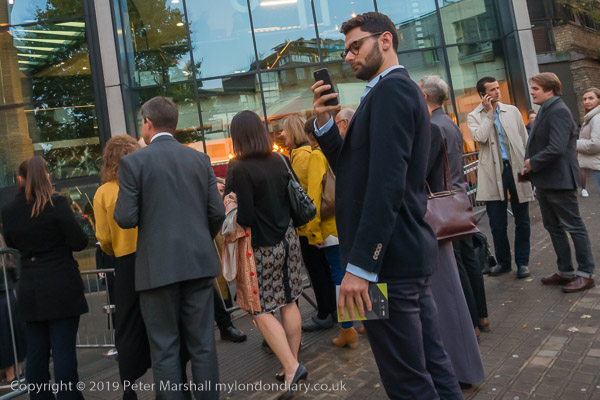
Simon Elmer of Architects for Social Housing (ASH) holds up a poster with the quote ‘Architecture Is Always Political’ from Richard Rogers, Fellow of the Royal Institute of British Architects at a protest on the pavement outside the RIBA on Portland Place on Thursday 15th Oct 2015.

The protest was against the nomination of NEO Bankside, a luxury development beside Tate Modern in London which breaks all planning requirements for social housing and sets a dangerous precedent for social cleansing for the prestigious Stirling Prize. Rogers was responsible for the design by Rogers Stirk Harbour + Partners of “the 217 apartments and penthouses in four Pavilions … with unparalleled views towards The City and St Paul’s Cathedral”. Or, as some might see it, degrading many views from the CIty and St Pauls. Some residents in the new development have taken and lost a case seeking to have the Tate Modern extension’s viewing platform closed as it overlooks their flats – and have now appealed to the Supreme Court, where a hearing is expected in December 2021. I hope it rejects their case. The flat dwellers could readily install blinds or curtains to protect their privacy.

The protesters stated on the reverse of the flyer that “this development is a class war against the poor and on the reverse explained why. NEO Bankside contains 217 homes with a market price ranging from £1.25 million to £19.75 million when 345,000 Londoners, 4% of the city’s population, are on council waiting lists for homes.”

NEO Bankside reduced the percentage of its affordable housing required uder Section 106 of the Town and Country Planning Act from 40% to a paltry 27.5%, by getting the property developers Native Land to undervalue the estimate of sales to just over half of the actual sale value.They then paid Southwark Council £11 million to build its reduced affordable housing quota off-site on land sold to them by the council for a pittance, demolishing a council-run children’s home and day-care nursery in the process.

ASH pointed out that rather than 217 luxury flats mainly for non-resident tax exiles and foreign investors, the cost of NEO Bankside could have built 2,260 Peabody flats at the cost per flat of another of the Stirling nominations. At a time when 42,000 families were evicted from rented accomodation last year and 88,000 London children will be homeless this winter, such buildings are clearly socially unacceptable.

Having made the flyer, at the protest they folded them into paper aeroplanes and made them fly, although the police threatened them with fines for littering (but they picked them all up after flying them) and then attempted to call paper aeroplanes offensive weapons and that flying them could constitute and assault – which was laughed out of court on the pavement as it would surely have also been had any case been taken.

The protest then carried out its own award ceremony, ‘The O J Simpson 2015 Prize for getting away with murder’, The winner was NEO Bankside, but no one from the architects came to claim it. Although most of those going into RIBA for the official ceremony (tickets at over £200 a head including VAT and booking fee) walked past trying to ignore the protest, there were some architects who stopped to share their reservations about NEO Bankside with the protesters, and it seems that RIBA had clearly been embarrassed by the revelations about NEO Bankside and were misled over some aspects of the scheme. The prize instead went to Burntwood School, an impressive revitalisation of a 1950s LCC comprehensive girls’ school in Wandsworth by architects Allford Hall Monaghan Morris (AHMM).

More pictures at NEO Bankside Stirling Prize nomination.










